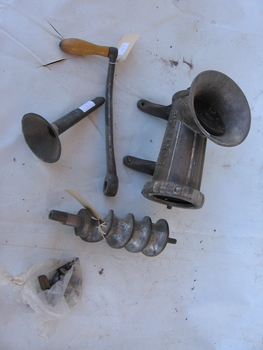Historical information
Era: This type of hand-cranked food mincer was popular in late 19th to mid-20th century kitchens, before the rise of electric meat grinders.
Use: Typically used for grinding meats, making sausages, or mincing vegetables, often as part of home food preservation.
Manual operation: The auger forces food through the grinding plate, allowing the user to control the consistency of the minced product.
Physical description
This is a vintage cast iron hand-cranked food mincer, consisting of several detachable parts. It is designed to grind meat, vegetables, or other food items by manually rotating the handle, which turns the auger inside the main body.
The components include:
Main body (casing): A heavy cast-iron structure with an open funnel at the top for inserting food. The body features a clamp or screw holes for securing it to a workbench or table.
Handle with wooden grip: A long metal arm with a rounded wooden handle, used for manually turning the auger.
Auger (screw-like piece): A large metal spiral component that pushes the food through the mincing plate when the handle is rotated.
Mincing plate (grinder disc): A perforated metal plate that determines the texture of the ground food.
Additional attachments: Includes a funnel-shaped attachment and small metal parts stored in a plastic bag, likely used for securing or adjusting the mincer.
The mincer shows signs of wear and oxidation, indicating age and prior use.
The wooden handle appears intact, but the metal components show some surface rust, which is typical for vintage kitchen tools.

